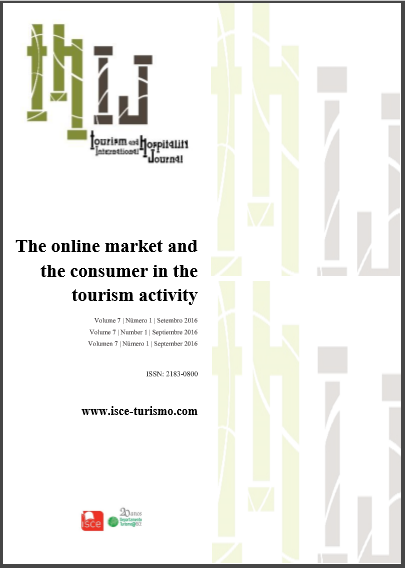Tourism and bank loans: what are the characteristics of tourists who use bank loans to travel?
DOI:
https://doi.org/10.57883/thij7(1)2016.30325Keywords:
Tourism, Credit, Consumer behavior, Bank loansAbstract
Sociodemographic changes in contemporary societies have a significant impact on tourism, as these affect tourism consumers behavior that seek alternative solutions to benefit from what they assume as a need (Gaulia, 2009). We witness the bird of a new era of consumers that look at tourism in a diferente way, willing to appeal to bank loans to realize their tourism wishes (Oliveira & Jesus, 2013). Thus, the objective of this study is to identify the diferences between tourist who use this credit strategy to participate in tourism and those who do not. For this, we developed an empirical exploratory study, based on a qualitative analysis, supported by semi-structured interviews. Results show that, potentially, people who use credit to go on vacation have distinctive characteristics, both in terms of family values and travel options, and also in terms of sociodemographic variables.
References
Alegre, J., & Pou, L. (2004). Micro-economic determinants of the probability of tourism consumption. Tourism Economics, 10(2), 125–144.
Alegre, J., Mateo, S., & Pou, L. (2010). An analysis of households’ appraisal of their budget constraints for potential participation in tourism. Tourism Management, 31, 45–56.
Alegre, J., Mateo, S., & Pou, L. (2013). Tourism participation and expenditure by Spanish households: The effects of the economic crisis and unemployment. Tourism Management, 39, 37-49.
Allen, L., DeLong, G., & Saunders, A. (2004). Issues in the Credit Risk Modeling of Retail Markets. Journal of Banking & Finance, 28(4), 727–752.
Alter, A., & Schuler, Y. (2012). Credit spread interdependencies of European states and banks during the financial crisis. Journal of Banking & Finance, 36(12), 3444-3468.
Banco de Portugal. (2015). Direitos e deveres dos consumidores de crédito. Lisboa: Banco de Portugal.
Barone, F. M., & Sader, E. (2008). Acesso ao crédito no Brasil: evolução e perspectivas. Revista de Administração Pública, 42(6), 1249-1267.
Berentsen, A., Camera, G., & Waller, C. (2007). Money, credit and banking. Journal of Economic Theory, 135, 171 – 195.
Bernanke, B., & Blinder, A. (1988). Credit, money, and aggregate demand. American Economic Review, 78(2), 435-439.
Bodosca, S., Gheorghe, G., & Nistoreanu, P. (2014). Tourist Consumption behaviour before and after the crisis from 2008. Procedia Economics and Finance, 16, 77 – 87.
Carr, N. (2005). Poverty, debt, and conspicuous consumption: University students tourism experiences. Tourism Management, 26, 797–806.
Crawford, D., Jackson, E., & Godbey, G. (1991). A hierarchical model of leisure constraints. Leisure Sciences, 13, 309-320.
Creswell, J. W. (2009). Research design: Qualitative, quantitative, and mixed methods approaches. Los Angeles: Sage Publications, Inc.
Crompton, J. L. (1979). Motivations for pleasure vacation. Annals of Tourism Research, 6(4), 408-424.
Crouch, G. I., Oppewal, H., Huybers, T., Dolnicar, S., Louvier, J. J., & Devinney, T. (2007). Discretionary expenditure and tourism consumption: Insights from a choice experiment. Journal of Travel Research, 45, 247-258.
Cruz, I. (2011). Práticas de consumo: O que faz a diferença? Sociologia On-line, 4, 7-25.
Denscombe, M. (2007). The good research guide for small-scale social research projects. Maidenhead, England: Open University Press.
Dolnicar, S., Crouch, G., Devinney, T., Huybers, T., Louviere, J., & Oppewalf, H. (2008). Tourism and discretionary income allocation: Heterogeneity among households. Tourism Management, 29, 44–52.
Flick, U. (2009). An introduction to qualitative research. Thousand Oaks: SAGE Publications.
Frade, C., & Jesus, F. (2011). Percepção do risco de crédito e endividamento sustentável. In H. V. Neto, & S. L. Coelho (Eds), Novas dimensões do consumo na sociedade contemporânea. Porto: Instituto de Sociologia-Faculdade de Letras.
Gaulia, C. T. (2009). O abuso de direito na concessão de crédito: O risco do empreendimento financeiro na Era do hiperconsumo. Revista da EMERJ, 12(47), 95-123.
Gilbert, D., & Abdullah, J. (2004). Holidaytaking and the sense of well-being. Annals of Tourism Research, 31(1), 103-121.
Hofmann, B. (2004). The Determinants of Bank Credit in Industrialized Countries: Do Property Prices Matter? International Finance, 7(2), 203–234.
Jennings, G. (2001). Tourism research. Milton, Australia: John Wiley and Sons Australia, Ltd.
Kuo, H., & Lu, C. (2013). Expenditure-based segmentation: Application of quantile regression to analyse the travel expenditures of baby boomer households. Tourism Economics, 19(6), 1429–1441.
Lima, J. (2015). Turismo em família: a importância do turismo para famílias economicamente carenciadas. Doutoramento em Turismo, Universidade de Aveiro.
Lipovetsky, G. (2007). A felicidade paradoxal: Ensaio sobre a sociedade do hiperconsumo. Lisboa: Cia. das Letras.
Marques, M., & Frade, C. (2003). Uma sociedade aberta ao crédito. Subjudice, 24, 27-34.
Oliveira, M., & Jesus, F. (2013). Arquitetura situacional do crédito: Tempo, cognição, afeto e decisão. Revista Crítica de Ciências Sociais, 101, 39 64.
Patton, M. Q. (2002). Qualitative research & evaluation methods. Thousand Oaks: SAGE Publications.
Portugal, Ministério da Economia. (2009). Contratos de crédito a consumidores. Decreto-Lei nº 133/ 2009 de 2 de junho, Série I, 4375-4384.
Quivy, R. (2005). Manual de investigação em ciências sociais. Lisboa: Gradiva.
Quivy, R., & VanCampenhoudt, L. (1998). Manual de investigação em ciências sociais. Lisboa: Gradiva.
Ritchie, J., & Lewis, J. (2003). Qualitative research practise: A guide for social science students and researchers. London: SAGE Publications.
VanderStoep, S. W., & Johnston, D. (2009). Research methods for real life: Blending qualitative and quantitative qpproaches. San Francisco: Jossey-Bass.
Veal, A. J. (2006). Research methods for leisure and tourism: A practical guide (3 ed.). Harlow: Pearson Education Limited.
Yin, R. K. (2011). Qualitative research from start to finish. New York: The Guilford Press.
Downloads
Published
How to Cite
Issue
Section
License
Copyright (c) 2023 This work is licensed under a Creative Commons - Attribution 4.0 International (CC BY 4.0)

This work is licensed under a Creative Commons Attribution 4.0 International License.
This work is published under the Creative Commons Attribution 4.0 International License.






